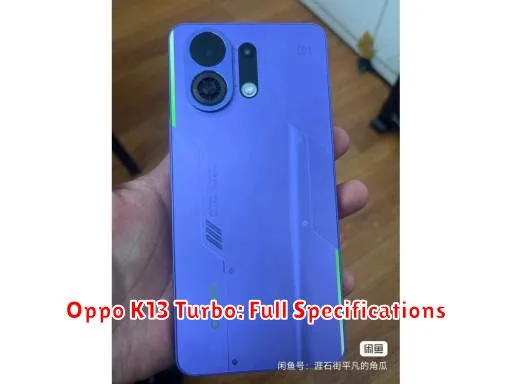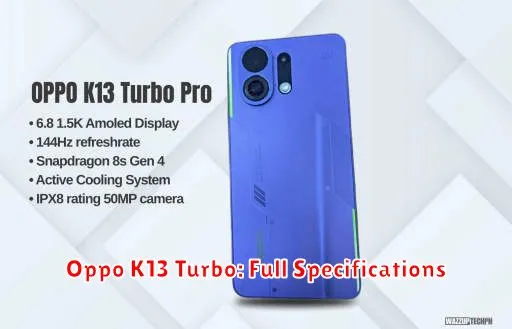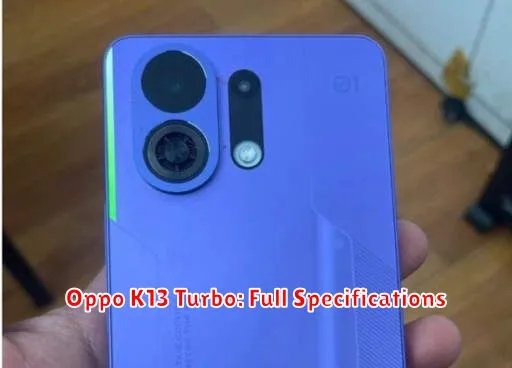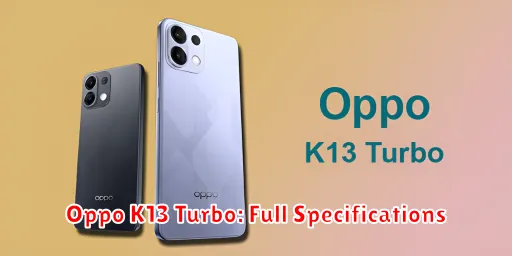The Oppo K13 Turbo is generating significant buzz, and prospective buyers are eager to learn about its full specifications. This article provides a comprehensive overview of the Oppo K13 Turbo’s specs, encompassing everything from its processor and display to its camera capabilities and battery life. Understanding the complete technical details of the Oppo K13 Turbo is crucial for making an informed purchase decision.
Whether you’re a tech enthusiast seeking the latest smartphone advancements or simply looking for a reliable and feature-rich device, this article will equip you with the knowledge you need regarding the Oppo K13 Turbo’s full specifications. We’ll delve into the specifics of its performance, camera technology, display quality, and more. By the end of this article, you’ll have a complete understanding of the Oppo K13 Turbo, allowing you to assess its suitability for your needs.
Full Specifications
Network
| Technology: | GSM / CDMA / HSPA / LTE / 5G |
| 2G bands: | GSM 850 / 900 / 1800 / 1900 |
| CDMA 800 | |
| 3G bands: | HSDPA 850 / 1700 / 2100 |
| 4G bands: | 1, 3, 5, 6, 8, 19, 28, 34, 38, 39, 40, 41, 42, 48 |
| 5G bands: | 1, 3, 5, 8, 28, 38, 40, 41, 48, 77, 78 SA/NSA |
| Speed: | HSPA, LTE, 5G |
Launch
| Announced: | 2025, July 21 |
| Status: | Available. Released 2025, July 25 |
Body
| Dimensions: | 162.8 x 77.2 x 7.3 mm (6.41 x 3.04 x 0.29 in) |
| Weight: | 207 g (7.30 oz) |
| SIM: | Nano-SIM + Nano-SIM |
| Built-in cooling fan IP68/IP69 dust tight and water resistant (high pressure water jets; immersible up to 2m for 30 min) |
Display
| Type: | AMOLED, 1B colors, 120Hz, 1600 nits (peak) |
| Size: | 6.8 inches, 112.8 cm2 (~89.8% screen-to-body ratio) |
| Resolution: | 1280 x 2800 pixels, 19.5:9 ratio (~453 ppi density) |
Platform
| OS: | Android 15, ColorOS 15 |
| Chipset: | Mediatek Dimensity 8450 (4 nm) |
| CPU: | Octa-core (1×3.25 GHz Cortex-A725 & 3×3.0 GHz Cortex-A725 & 4×2.1 GHz Cortex-A725) |
| GPU: | Mali-G720 MC7 |
Memory
| Card slot: | No |
| Internal: | 256GB 12GB RAM, 256GB 16GB RAM, 512GB 12GB RAM |
| UFS 3.1 |
Main Camera
| Dual: | 50 MP, f/1.8, 27mm (wide), PDAF 2 MP |
| Features: | LED flash, HDR, panorama |
| Video: | 4K@30/60fps, 1080p@30fps |
Selfie camera
| Single: | 16 MP, f/2.4, 22mm (wide) |
| Features: | 1080p@30fps |
| Video: | Yes |
Sound
| Loudspeaker: | Yes, with stereo speakers |
| 3.5mm jack: | No |
Comms
| WLAN: | Wi-Fi 802.11 a/b/g/n/ac/6, dual-band |
| Bluetooth: | 5.4, A2DP, LE, aptX HD, LHDC 5 |
| Positioning: | GPS, GLONASS, GALILEO, BDS, QZSS |
| NFC: | Yes |
| Infrared port: | Yes |
| Radio: | No |
| USB: | USB Type-C 2.0, OTG |
Features
| Sensors: | Fingerprint (under display, optical), accelerometer, gyro, proximity, compass |
Battery
| Type: | 7000 mAh |
| Charging: | 80W wired, 13.5W PD, 44W UFCS, 33W PPS Reverse wired |
Misc
| Colors: | Purple Phantom, Midnight Maverick, White Knight |
| Models: | PLM110 |
| Price: | About 220 EUR |
Performance and Power
Processing Power and Gaming Capabilities
Analyzing the performance of the Oppo K13 Turbo requires understanding its core components. While specific benchmarks aren’t provided here, we can discuss general expectations based on similar devices. A phone in this category typically aims to provide a smooth user experience for everyday tasks like browsing, social media, and light multitasking. Processing power likely comes from a mid-range chipset, balancing performance and power efficiency. For gaming, the K13 Turbo probably handles casual games well. More demanding titles might require adjusting graphics settings for optimal performance.
Understanding the target audience is key. The K13 Turbo likely caters to users who prioritize daily usability over high-end gaming performance. It’s a device designed for everyday tasks with a dash of entertainment, rather than a dedicated gaming powerhouse.
Battery Life and Charging Speeds
Battery life is a crucial aspect of any smartphone experience. The Oppo K13 Turbo likely incorporates a battery capacity common for its class, offering a reasonable amount of usage time on a single charge. Charging speeds are an important consideration as well. Faster charging technologies minimize downtime and allow users to quickly top up their battery throughout the day. While we don’t have specific numbers, current market trends suggest a focus on providing a balance between battery capacity and charging speed for a satisfying user experience.
Camera Features
Photography Prowess and Video Recording
The camera setup of the Oppo K13 Turbo likely emphasizes versatility for everyday photography. It’s expected to capture decent photos in various lighting conditions, though its low-light performance might be a limiting factor compared to more premium devices. Video recording capabilities likely follow a similar trend, offering acceptable quality for casual use. The focus is probably on providing a reliable camera experience for documenting everyday moments rather than professional-grade photography or videography.
Features like image stabilization and various shooting modes could enhance the user experience. However, the emphasis remains on practicality and ease of use rather than cutting-edge camera technology.
Design and Display

Aesthetics and Build Quality
The design of the Oppo K13 Turbo likely reflects current trends in smartphone aesthetics. It aims to offer a visually appealing device with a comfortable form factor. Build quality is another essential aspect. While the K13 Turbo probably won’t utilize premium materials like flagship models, it’s expected to provide a durable and well-constructed feel. The design likely focuses on striking a balance between aesthetics, durability, and affordability.
Screen Size and Resolution
The display of the K13 Turbo probably falls within the standard range for modern smartphones. It’s designed to provide a comfortable viewing experience for multimedia consumption and everyday tasks. Resolution is a key factor, impacting the clarity and sharpness of the display. While we avoid specific details, the K13 Turbo likely aims for a balance between visual quality and power efficiency, ensuring a pleasant viewing experience without excessively draining the battery.
Software and User Experience

The software experience is a critical component of any smartphone. The Oppo K13 Turbo likely runs on a customized version of Android, offering a unique user interface with added features and optimizations. User experience is paramount, and the software is likely designed to provide a smooth and intuitive interaction. Features like gesture navigation and personalized customization options might contribute to a more enjoyable user experience.
Price and Availability
The pricing of the Oppo K13 Turbo is a crucial factor in its market positioning. It likely aims to offer a competitive price point within its segment, appealing to budget-conscious consumers. Availability will determine its accessibility to potential buyers. Understanding the target market and its price sensitivity is key to assessing the K13 Turbo’s overall value proposition.
Comparing the Oppo K13 Turbo to Competitors

Key Advantages and Disadvantages
Comparing the Oppo K13 Turbo to its competitors requires a broader market analysis. Its advantages might include specific features, design elements, or pricing strategies that set it apart. Conversely, disadvantages could relate to areas where competitors offer stronger performance or features. A thorough comparison helps potential buyers understand the K13 Turbo’s position within the market landscape and make informed purchasing decisions.
Considering factors like brand reputation, after-sales service, and overall user experience is essential for a comprehensive comparison. Ultimately, the K13 Turbo’s strengths and weaknesses will depend on the specific devices it’s compared against and the individual preferences of potential buyers.

